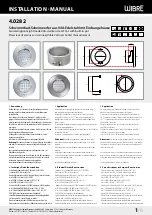
21-40-01
99M90
Page: 5-2
Issued: May 9, 2012
Rev. New
I-Series Combustion Heater
Owners Manual
5.3
Periodic Inspection Checks (cont’d)
Note:
It is recommended that a timing meter be used on the heater
assembly to establish heater hours of operation. If a
timing
meter is not used,
count one (1) heater hour for each two (2)
flight hours for normal aircraft operation. If the heating system is
used excessively in ground operations, the exact time of this
operation must be used for inspection and overhaul purposes
(calculation does not apply).
50 Hours time in service
(one time overhauled, rebuilt, or new).
Inspect the ventilating air inlet scoop, combustion air inlet scoop, exhaust outlet and fuel
drain for possible obstructions and clear. Check that no damage has occurred to air
scoop protrusions. Look in the area of the heater exhaust tube for a large or unusual
accumulation of soot on the skin of the aircraft. This indicates a "rich" burning condition
and requires troubleshooting. Perform operational check of the heater per para. 5.2.
100 Hours time in service and each 100 hours thereafter
(at annual inspection or each 12 months, the first of these to occur).
Inspection shall be conducted on all I-Series heaters (including new, rebuilt, upgraded, or
overhauled). The 100 Hour Inspection consists of the items listed below. Refer to
maintenance Chapter 8 of this manual, the applicable chapter of HET P/N 99M91
Overhaul & Maintenance manual, or the applicable aircraft/rotorcraft service manuals for
appropriate details.
1.
Inspect ventilating and combustion air inlets and exhaust outlet for restrictions and
security at the aircraft skin line. Check any external scoop and make sure they are not
distorted and are securely attached to the aircraft
2.
Inspect the drain line to make sure it is free of obstructions. Run a wire of the
appropriate length through it if necessary to clear any obstruction.
3.
Check all fuel lines for security at joints and shrouds, making sure that no evidence of
leaks exists. Also check for security of attachment of fuel lines at the various attaching
points in the aircraft. Check any fuel filter or scupper if incorporated.
4.
Inspect electrical wiring at the heater terminal block and components for loose
connections, possible chaffing of insulation, and security of attachment points.
5.
Inspect the high voltage cable connection at the spark plug to make sure it is right.
Also, examine the cable sheath for any possible indications of arcing.
6.
Inspect the combustion air blower assembly for security of mounting, tube connections and
wiring. Tighten any loose electrical terminals and air tube connections.
7.
Operate both the combustion air blower and ventilating air blower and check for unusual
noise or vibrations. Refer to Table 3.1 “Troubleshooting” for diagnosis.
9.
Following the 100 hour inspection, perform the preflight operating check as described
in Chapter 5, paragraph 5.2.
*
I-Series heaters use
Inconel®
steel combustion tubes which are marked
IS
at the end
of the applicable part number for identification.
















































